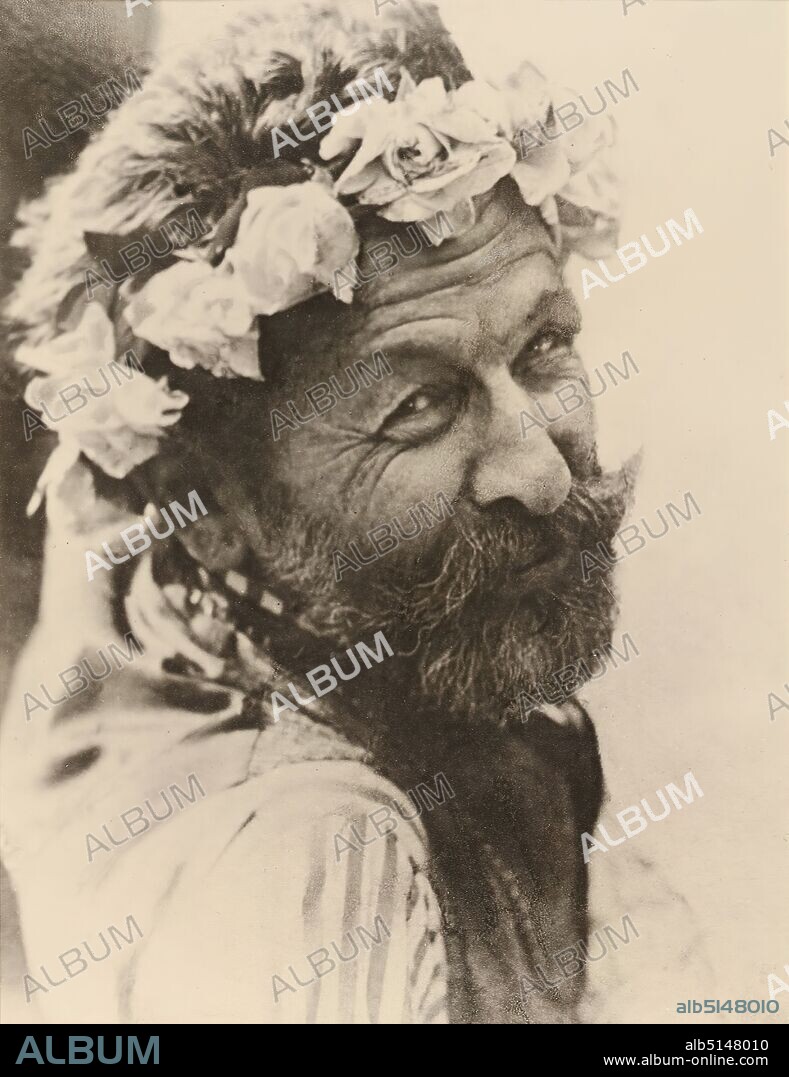alb5148010
Hugo Erfurth, Richard Dehmel, from the album Ausstellung Hugo Erfurth - Bildnisse aus dem XX. Jahrhundert, Konstanz 1949, silver gelatin paper, black and white positive process, passepartout : height: 22.8 cm; width: 17.5 cm, inscribed: Passepartout recto u. in the middle: in typescript on Japan paper: H u g o E r f u r t h, '''Richard Dehmel'', stamp: Passepartout verso and left: inscribed: Passepartout verso and: in lead: (around 1910), gelatin silver, repro no, portrait photography, portrait, wreath, garland, At the beginning of the 20th century, Hugo Erfurth, along with Rudolph Dührkoop and Nicola Perscheid, was one of the most famous professional photographers in Germany. After completing an apprenticeship as a photographer, he opened his own studio in Dresden at the age of only 22. Soon Erfurth orientated himself towards the up-and-coming pictorialist photography, participated in numerous amateur photographic exhibitions from 1894 onwards and managed to make a name for himself both as an artistically ennobled amateur and successful professional photographer. Portraits are central to his work, which he began taking in 1906 in his new studio, a classicist palace, in a stylishly elegant ambience, appealing to the wealthy bourgeoisie. He also produced numerous portraits of famous personalities, including Käthe Kollwitz, Otto Dix and Joachim Ringelnatz. While his studies around 1905 still show full-length figures depicted in an atmospheric way, from the 1920s onward the focus is on the face, which is photographed against a simple monochrome background. Here, his pictorial approach corresponds to the portrait of classical modernism, whereby the technique of oil printing emphasizes the softness and materiality of the pigments and at the same time places the portraits in the art-photographic tradition. Erfurth is a co-founder of the Gesellschaft Deutscher Lichtbildner (1919), teaches at the Leipzig Academy and moves from Dresden to Cologne in the 1930s, where he bui.

|
Zu einem anderen Lightbox hinzufügen |
|
Zu einem anderen Lightbox hinzufügen |



Haben Sie bereits ein Konto? Anmelden
Sie haben kein Konto? Registrieren
Dieses Bild kaufen

Untertitel:
Siehe automatische Übersetzung
Hugo Erfurth, Richard Dehmel, from the album Ausstellung Hugo Erfurth - Bildnisse aus dem XX. Jahrhundert, Konstanz 1949, silver gelatin paper, black and white positive process, passepartout : height: 22.8 cm; width: 17.5 cm, inscribed: Passepartout recto u. in the middle: in typescript on Japan paper: H u g o E r f u r t h, '''Richard Dehmel'', stamp: Passepartout verso and left: inscribed: Passepartout verso and: in lead: (around 1910), gelatin silver, repro no, portrait photography, portrait, wreath, garland, At the beginning of the 20th century, Hugo Erfurth, along with Rudolph Dührkoop and Nicola Perscheid, was one of the most famous professional photographers in Germany. After completing an apprenticeship as a photographer, he opened his own studio in Dresden at the age of only 22. Soon Erfurth orientated himself towards the up-and-coming pictorialist photography, participated in numerous amateur photographic exhibitions from 1894 onwards and managed to make a name for himself both as an artistically ennobled amateur and successful professional photographer. Portraits are central to his work, which he began taking in 1906 in his new studio, a classicist palace, in a stylishly elegant ambience, appealing to the wealthy bourgeoisie. He also produced numerous portraits of famous personalities, including Käthe Kollwitz, Otto Dix and Joachim Ringelnatz. While his studies around 1905 still show full-length figures depicted in an atmospheric way, from the 1920s onward the focus is on the face, which is photographed against a simple monochrome background. Here, his pictorial approach corresponds to the portrait of classical modernism, whereby the technique of oil printing emphasizes the softness and materiality of the pigments and at the same time places the portraits in the art-photographic tradition. Erfurth is a co-founder of the Gesellschaft Deutscher Lichtbildner (1919), teaches at the Leipzig Academy and moves from Dresden to Cologne in the 1930s, where he bui
Persönlichkeiten:
Bildnachweis:
Album / quintlox
Freigaben (Releases):
Model: Nein - Eigentum: Nein
Rechtefragen?
Rechtefragen?
Bildgröße:
3330 x 4320 px | 41.2 MB
Druckgröße:
28.2 x 36.6 cm | 11.1 x 14.4 in (300 dpi)
Schlüsselwörter:
ARCHIV • BLACK • DEUTSCHLAND • GESICHT • HUGO ERFURTH • II. WELTKRIEG • JOACHIM RINGELNATZ • NICOLA PERSCHEID • PORTRAIT • RICHARD DEHMEL • RUFEN • SCHWARZ • STUDIEN • STUDIUM • TECHNIK
 Pinterest
Pinterest Twitter
Twitter Facebook
Facebook Link kopieren
Link kopieren Email
Email
